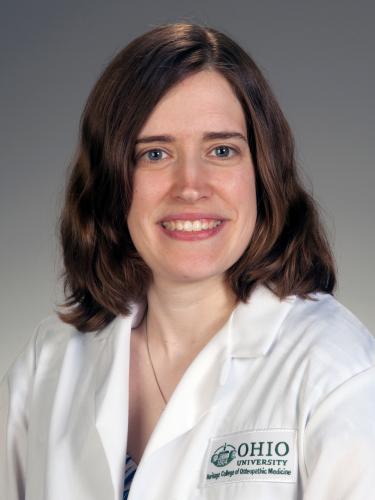
OHIO continues to lead in diabetes work, helps standardize fellowship curriculum

In 2004, Ohio University became one of the first in the country to offer a diabetes fellowship, a one-year program for physicians who focus on clinical diabetes care and research. Now, OHIO has also lent a hand in standardizing curriculum for the nation’s diabetes fellowship programs.
There are currently six diabetes fellowship programs across the United States. Last year, the fellowship directors began talks of standardizing curriculum across the programs for accreditation. Those discussions included Amber Healy, D.O. (’09), an assistant clinical professor at the Heritage College of Osteopathic Medicine and the director of the diabetes fellowship program, now housed at OhioHealth O’Bleness and supported by the Heritage College’s Diabetes Institute.
“Uniform standards will make it easier for other programs to be developed. Our hope is that there will be more programs, and it will lead to the creation of a board and certification,” Healy said. “These programs lacking certification has been one of the biggest barriers cited by physicians who have identified themselves as diabetologists.”
The directors and others involved in the fellowships, including Sarah Adkins, PharmD, associate director of OHIO’s Diabetes Institute, attended a January 2020 meeting where they had breakout sessions and discussions about standards, education competencies and barriers to practicing diabetology.
From those discussions, Healy and others authored a white paper detailing their proposed standards and procedures in providing diabetes care, which was published in Clinical Diabetes, a publication of the American Diabetes Association. The paper comes just in time for Diabetes Awareness Month, which is every November.
“In the long run, we are hoping to improve the treatment of diabetes and prevent complications of diabetes and to have our own specialty that focuses on this complex disease process,” Healy said. “We are hoping to provide specialty access to diabetes care in areas that might not otherwise have it.”
Other authors of the paper include Jay Shubrook, D.O. (’96), former Heritage College faculty member, and Frank Schwartz, M.D., professor emeritus of specialty medicine. Shubrook and Schwartz founded the diabetes fellowship program at OHIO.
“This [program] has been impactful to this region, as rural areas do not usually have endocrinologists available. Our program has drawn endocrinologists here, as well as brought primary care physicians seeking training in diabetes expertise to our region to provide care for diabetes in an underserved area,” Healy said. “This program is also what brought me back to the region after I completed my residency.”
The Centers for Disease Control and Prevention recently reported that there are 34.2 million people with diabetes in the United States, and also 88 million adults, approximately one out of three, who have prediabetes. Studies have indicated that rates might be even higher in Appalachian regions, including southeast Ohio.
However, there is a shortage of endocrinologists who traditionally treat diabetes, especially in rural areas. Although primary care providers can care for diabetes patients, time constraints in office visits can make it difficult to address diabetes to the depth that is needed, especially when there may be other concerns that need to be addressed during the appointment.
Healy notes that the hope for these fellowship programs is that they will help doctors be able to give informed, adequate care when it comes to diabetes.
“There has been an increase in the number of medications and an expansion in the technology available to manage diabetes in recent years, and the research continues to expand, which is a lot of information to keep up with,” she said. “Diabetologists are trained in these medications and technologies. More primary care physicians trained in diabetology programs can potentially increase access to these technologies and improve patient outcomes.”
